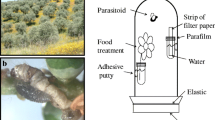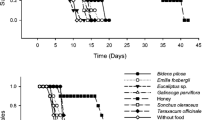Abstract
Olive fruit fly Bactrocera oleae (Rossi) (Diptera: Tephritidae) is a major olive pest in the Mediterranean basin where increasing insecticide resistance has enhanced damage and necessitates more reliance on other control strategies, such as biological control. Provision of floral resources has been reported to improve the effectiveness of natural enemies. Here, we tested the effect of six plant nectars and two honeydew sources on the survival of Psyttalia concolor (Szépligeti) (Hymenoptera: Braconidae), a parasitoid wasp used in the biological control of olive fruit fly. Our results showed a positive effect on survival associated with nectars of Anchusa azurea Mill., Rosmarinus officinalis L., Lavatera cretica L. and Calamintha nepeta (L.) Savi, while honeydew proved to be a valuable alternative food source. When offering flowers directly to insects, Anchusa azurea, Lavatera cretica, and Foeniculum vulgare L. were found to be the most beneficial species, indicating also that P. concolor feeds predominantly on shallow corollas.

Similar content being viewed by others
References
Albajes R, Santiago-Alvarez C (1980) Efectos de la densidad larvária y de la alimentación en proporción de sexos de Ceratitis capitata (Diptera: Thrypetidae). An INIA Ser Agric 13:175–182
Baker HG, Baker I (1983) Floral nectar sugar constituents in relation to pollinator type. In: Jones CE, Little RJ (eds) Handbook of experimental pollination biology. Scientific & Academic Editions, van Nostrand Reinhold, New York, pp 117–141
Beach JP, Williams L III, Hendrix DL, Price LD (2003) Different food sources affect the gustatory response of Anaphes iole, an egg parasitoid of Lygus spp. J Chem Ecol 29:1203–1222
Belo AF, Simões MP, Pinto-Cruz C, Castro MC (2009) Efeitos da gestão do coberto do solo na diversidade vegetal de olival. In: Actas do XII Congresso da SEMh/XIX Congresso da ALAM/II Congresso da IBCM, vol 1:61–64
Benelli G, Canale A (2012) Learning of visual cues in the fruit fly parasitoid Psyttalia concolor (Szépligeti) (Hymenoptera: Braconidae). BioControl 57:767–777
Benelli G, Canale A, Flamini G, Cioni PL, Demi F, Ceccarini L, Macchia M, Conti B (2013a) Biotoxicity of Melaleuca alternifolia (Myrtaceae) essential oil against the Mediterranean fruit fly, Ceratitis capitata (Diptera: Tephritidae), and its parasitoid Psyttalia concolor (Hymenoptera: Braconidae). Ind Crops Prod 50:596–603
Benelli G, Gennari G, Francini A, Canale A (2013b) Longevity costs of same-sex interactions: first evidence from a parasitic wasp. Invertebr Biol 132(2):156–162
Benelli G, Revadi S, Carpita A, Giunti G, Raspi A, Anfora G, Canale A (2013c) Behavioral and electrophysiological responses of the parasitic wasp Psyttalia concolor (Szépligeti) (Hymenoptera: Braconidae) to Ceratitis capitata-induced fruit volatiles. Biol Control 64:116–124
Benelli G, Daane KM, Canale A, Niu C, Messing RH, Vargas RL (2014) Sexual communication and related behaviours in Tephritidae: current knowledge and potential applications for integrated pest management. J Pest Sci 87:385–405
Bueno AM, Jones O (2002) Alternative methods for controlling the olive fly, Bactrocera oleae, involving semiochemicals. IOBC/WPRS Bull 25:1–11
Canale A, Benelli G (2012) Impact of mass-rearing on the host seeking behaviour and parasitism by the fruit fly parasitoid Psyttalia concolor (Szépligeti) (Hymenoptera: Braconidae). J Pest Sci 85:65–74
Canale A, Benelli G, Conti B, Lenzi G, Flamini G, Francini A, Cioni PL (2013) Ingestion toxicity of three Lamiaceae essential oils incorporated in protein baits against the olive fruit fly, Bactrocera oleae (Rossi) (Diptera: Tephritidae). Nat Prod Res 27(22):2091–2099
Coll M, Guershon M (2002) Omnivory in terrestrial arthropods: mixing plant and prey diets. Ann Rev Entomol 47:267–297
Corbet SA, Delfosse ES (1984) Honeybees and the nectar of Echium plantagineum L. in south–eastern Australia. Aust J Ecol 9:125–139
Coutinho AXP (1939) Flora de Portugal: plantas vasculares, 2nd edn. Bertrand, Lisboa
Culvenor CCJ, Edgar JA, Smith LW (1981) Pyrrolizidine alkaloids in honey from Echium plantagineum L. J Agric Food Chem 29:958–960
Daane KM, Johnson MW (2010) Olive fruit fly: managing an ancient pest in modern times. Annu Rev Entomol 55:151–169
Daane KM, Johnson MW, Pickett CH, Sime KR, Nadel H Jr, Andrews JW, Hoelmer KA (2011) Biological controls investigated to aid management of olive fruit fly in California. Calif Agric 65:21–28
Delrio G, Lentini A, Satta A (2005) Biological control of olive fruit fly through inoculative releases of Opius concolor Szépl. IOBC/WPRS Bull 28(9):53–58
Gilbert F, Jervis MA (1998) Functional, evolutionary and ecological aspects of feeding-related mouthpart specialization in parasitoid flies. Biol J Linn Soc 63:495–535
Idoine K, Ferro DN (1988) Aphid honeydew as a carbohydrate source for Edovum puttleri (Hymenoptera: Eulophidae). Environ Entomol 17:941–944
Idris AB, Grafius E (1995) Wildflowers as nectar sources for Diadegma insulare (Hymenoptera: Ichneumonidae), a parasitoid of diamondback moth (Lepidoptera: Yponomeutidae). Environ Entomol 24:1726–1735
Jacas JA, Viñuela E (1994) Side effects of pesticides on Opius concolor Szépl (Hymenoptera: Braconidae), a parasitoid of the olive fly. IOBC/WPRS Bull 17(10):143–146
Jiménez A, Esteban JR, Castillo E, Melero FJ, Avilés M (2002). Lucha integrada en el olivar: ensayos en condiciones reales y nuevas metodologias. Jornadas Técnicas del Aceite de Oliva. Madrid (España), 23–24 April
Kakani EG, Sagri E, Omirou M, Ioannides IM, Mathiopoulos KD (2014) Detection and geographical distribution of the organophosphate resistance-associated Δ3Q ace mutation in the olive fruit fly, Bactrocera oleae (Rossi). Pest Manag Sci 70(5):743–750
Lee JC, Heimpel GE, Leibee GL (2004) Comparing floral nectar and aphid honeydew diets on the longevity and nutrient levels of a parasitoid wasp. Entomol Exp Appl 111(3):189–199
Nepi M, Selvi F, Pacini E (2010) Variation in nectar-sugar profile of Anchusa and allied genera (Boraginaceae). Bot J Linn Soc 162:616–627
Nicolson SW (2007) Nectar consumers. In: Nicolson SW, Nepi M, Pacini E (eds) Nectaries and nectar. Springer, Dordrecht, pp 289–342
Olson DM, Andow DA (1998) Larval crowding and adult nutrition effects on longevity and fecundity of female Trichogramma nubilale Ertle and Davis (Hymenoptera: Trichogrammatidae). Environ Entomol 27:508–514
Paredes D, Cayuela L, Campos M (2013a) Synergistic effects of ground cover and adjacent vegetation on natural enemies of olive insect pests. Agric Ecosyst Environ 173:72–80
Paredes D, Cayuela L, Gurr GM, Campos M (2013b) Effect of non-crop vegetation types on conservation biological control of pests in olive groves. PeerJ 1:e116
Patt JP, Hamilton GC, Lashomb JH (1997) Foraging success of parasitoids wasps on flowers: interplay of insect morphology, floral architecture and searching behavior. Entomol Exp Appl 83:21–30
Pinheiro L, Torres L, Raimundo J, Santos SP (2013) Effect of floral resources on longevity and nutrient levels of Episyrphus balteatus (Diptera: Syrphidae). Biol Control 67(2):178–185
Rice RE, Phillips PA, Stewart-Leslie J, Sibbett GS (2003) Olive fruit fly populations measured in central and southern California. Calif Agric 57:122–127
Rugman-Jones PF, Wharton R, Noort TV, Stouthamer R (2009) Molecular differentiation of the Psyttalia concolor (Szépligeti) species complex (Hymenoptera: Braconidae) associated with the olive fly, Bactrocera oleae (Rossi) (Diptera: Tephritidae), in Africa. Biol Control 49:17–26
Tompkins J-ML, Wratten SD, Wäckers FL (2010) Nectar to improve parasitoid fitness in biological control: Does the sucrose:hexose ratio matter? Basic Appl Ecol 11(3):264–271
Tzanakakis ME (2003) Seasonal development and dormancy of insects and mites feeding on olive: a review. Neth J Zool 52:87–224
Vattala HD, Wratten SD, Phillips CB, Wäckers FL (2006) The influence of flower morphology and nectar quality on the longevity of a parasitoid biological control agent. Biol Control 39(2):179–185
Wäckers FL (2000) Do oligosaccharides reduce the suitability of honeydew for predators and parasitoids? A further facet to the function of insect-synthesized honeydew sugars. Oikos 90:197–201
Wäckers FL (2004) Assessing the suitability of flowering herbs as parasitoid food sources: flower attractiveness and nectar accessibility. Biol Control 29(3):307–314
Wäckers FL (2005) Suitability of (extra-) floral nectar, pollen, and honeydew as insect food sources. In: Wäckers FL, van Rijn PCJ, Bruin J (eds) Plant-provided food for carnivorous insects: a protective mutualism and its applications. Cambridge University Press, Cambridge, pp 17–74
Wäckers FL, van Rijn PCJ (2012) Pick and mix: selecting flowering plants to meet the requirements of target biological control insects. In: Gurr G (ed) Biodiversity and insect pests: key issues for sustainable management. Wiley Blackwell, Hoboken, pp 139–165
Wäckers FL, van Rijn PCJ, Heimpel GE (2008) Honeydew as a food source for natural enemies: making the best of a bad meal? Biol Control 45:176–184
Acknowledgments
This research is part of a project devoted to Increasing functional biodiversity in olive groves to enhance conservation biological control of insect pests. Research was financially supported by Fundação para a Ciência e Tecnologia (FCT), with partial funding from the European Fund for Regional Development, through the project PTDC/AGR‐AAM/100979/2008 Increasing functional biodiversity in olive groves to enhance conservation biological control of insect pests. We thank Dr. Flor Budia, Dr. Pedro Del Estal and Luís Queirós from the Entomology Laboratory of the Universidade Complutense of Madrid, for their help and for providing the initial populations of C. capitata and P. concolor, necessary to establish the colonies used in this research.
Author information
Authors and Affiliations
Corresponding author
Additional information
Handling Editor: Stefano Colazza
Electronic supplementary material
Below is the link to the electronic supplementary material.
Rights and permissions
About this article
Cite this article
Furtado, C., Belo, A.F., Nunes, F.M. et al. Evaluating potential olive orchard sugar food sources for the olive fly parasitoid Psyttalia concolor . BioControl 61, 473–483 (2016). https://doi.org/10.1007/s10526-016-9732-5
Received:
Accepted:
Published:
Issue Date:
DOI: https://doi.org/10.1007/s10526-016-9732-5




